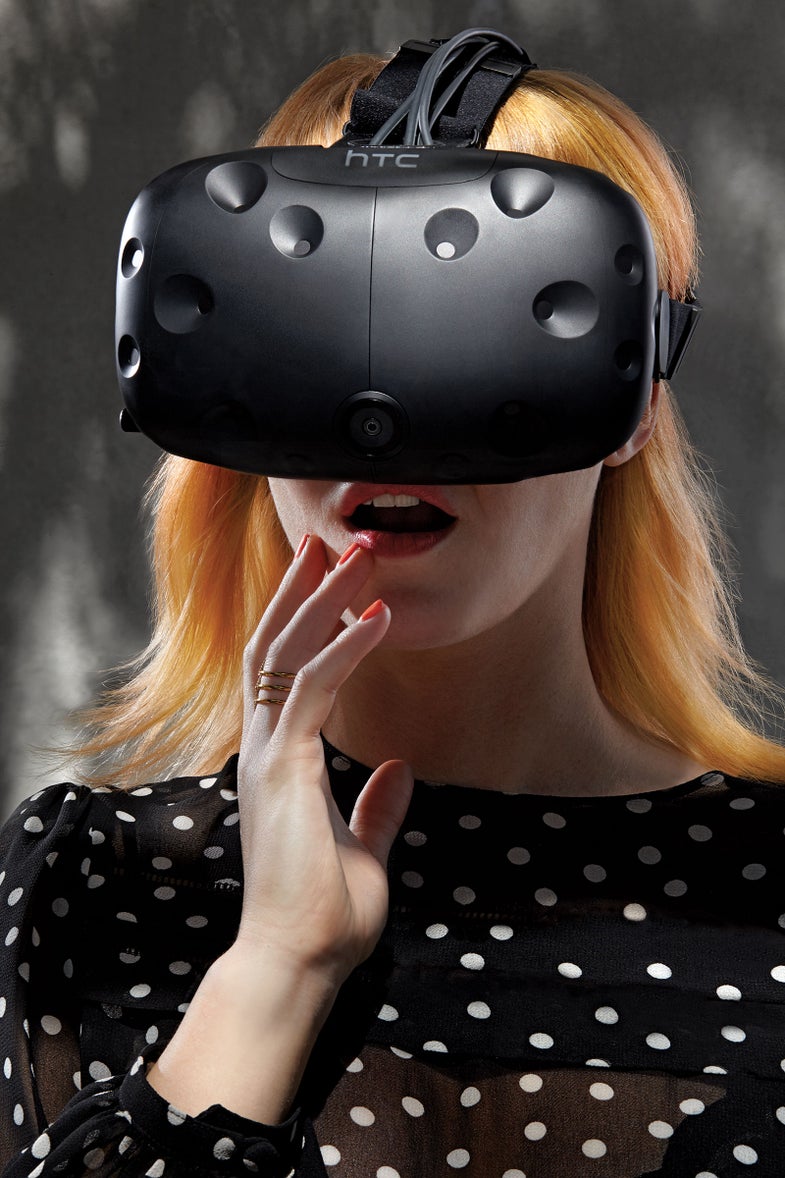Virtualandia: The Hottest New Real Estate Is In The Ether
As everybody moves in to virtual reality, who's making the rules?

We may earn revenue from the products available on this page and participate in affiliate programs. Learn more ›

I’m standing inside a moving subway car. It’s dimly lit, but I can make out the layer of grime on the doors and windows.
A man’s disembodied voice tells me to pick up a silver handgun sitting on a seat to my right. “You better be ready to shoot,” he says. My stomach tightens as the station platform comes into view. The doors open. I pick up the gun and start firing. Torsos explode. Strangers run at me. I squeeze rounds. More blood. When I run out of bullets, I grab a rifle. Shadows hit the platform. Then, from out of nowhere, rockets fly my way. Overwhelmed—and a little nauseous—I throw my hands in front of my face, terrified, and tear off my virtual-reality goggles.
For five minutes, I’ve been riding Bullet Train, a VR demo from Epic Games, while standing in a dark padded booth in downtown San Francisco. Epic is one of 550 vendors at the Game Developer Conference, a five-day tech fest at the Moscone Center exhibition complex. I look around. The two young female game reps are grinning, like “Way cool, right?” This is Silicon Valley, after all, land of the future. My adrenaline is spiking. My palms are a sweaty puddle of fear and sudden relief.
The thrill of first-person-shooter games is well-known. Their adrenaline rush is the currency of a $90 billion dollar gaming industry built on skill, competence, and fantasy alter egos. But with those games, we’ve always been aware that we are in our living room, bowl of chips and Red Bull at the ready—until now. VR isn’t just an incremental improvement in technology, like better graphics and faster processing; it’s a different encounter entirely—one that tricks your senses into experiencing the virtual as real. “Presence” is the primary buzzword tossed around at the GDC’s first-ever virtual-reality track, the perception that you’re not just watching the action. You are in the action.
“It’s the first medium that creates the sensation that you’re somewhere else,” says Tim Sweeney, founder and CEO of Epic Games. It is so realistic, you have a hard time doing things contrary to your intuition. “If you’re standing at the edge of a chasm, even though you’re really just standing in a room,” says Sweeney, “you’re afraid to step forward.”
“Transformative” is another descriptor favored by the young VR evangelists, who tout headsets with the enthusiasm of 19th-century carnival barkers. See the future right before your very eyes! Travel continents without a passport! Dine with the dinosaurs!
This year, tens of millions of people will likely buy VR headsets. The Oculus Rift, HTC Vive, Samsung Gear, and Google Cardboard are in homes already—and Sony’s PlayStation VR will soon join them, connecting to millions of consoles. It’s not only games. VR is taking root in education, healthcare, sports, architecture, and porn. A handful of early research suggests VR embeds itself deeper in our psyche, stays with us longer, and can alter our behavior longer afterward than any other type of media we consume. It’s been shown to influence racial and sexual stereotypes. It has triggered emotional rewiring in users. With such great power comes great responsibility. Will our immersive travels make us the best versions of ourselves? Or the worst? Should people be allowed to virtually act out anything they choose? What about rape fantasies? What happens when you virtually kill people and feel like you actually did?
When researchers show people traditional media, such as TV and movies, and then subject them to similar content in virtual reality, they are initially affected by both equally. But a week later, “they forget their exposure to everything but the VR scenario,” says Sun Joo Ahn, a researcher at the University of Georgia. “What they experience in a sensory way sticks with them over time. The effects are persistent.”
Consider too the racial and gender stereotyping issues already plaguing the gaming and entertainment industries. When the line between real and unreal becomes blurrier, do we need different rules?

Being a woman at GDC is like being a brunette in Sweden—you exchange knowing nods with other members of your tribe. You also studiously avoid herds of men with unkempt beards. Spread across three giant buildings at Moscone, it’s Disneyland for gamers. There are booth babes and dudes in tees walking with their phones out, capturing every moment. The VR track is jam-packed with the kind of buzz befitting a technology at an inflection point. The popular kids on the block—the aforementioned Epic, Oculus, Sony, Google, and Samsung—required appointments to experience their wares. All told, I road-tested five VR games and didn’t encounter a single female or minority onscreen. EVE: Valkyrie, one of two video games bundled with the Rift, does feature a female military captain—and black soldiers are not uncommon in war games—but, as in all video games, they tend to play to stereotypes. That’s no accident.
“If a company’s already sold a trillion copies of Grand Theft Auto in which we smack around women and sexualize them, why change that?” asks Jesse Fox, a researcher I spoke to at Ohio State University. “If companies are already taking a risk on a new technology, they’re not also going to take risks with different types of content.”
Fox studies the way in which new media technologies—including VR, video games, and social networking—influence our offline identities, beliefs, and behaviors. She has studied how virtual virgins and female vamps altered users’ real-world attitudes. After exposing research subjects to virgin and vamp characters in VR, Fox found women and men are both more likely to buy into the rape myth: the idea that women have an unconscious desire to be raped.
“In media studies, we’ve seen that people will look to confirm their biases,” Fox says. “If you think all black men are criminals, for example, you might see a black male criminal in a film and go, ‘See, I was right.’” Extending those stereotypes into VR, where interactions feel more real, could reinforce them further. “If there are men who see women as sluts and teases, and then they interact with avatars that play into those stereotypes in virtual reality,” she says, “then the more their ideas are confirmed, and the more they’ll believe them.”
Extreme uses of VR might be inevitable. “Say I’m a teenage boy who gets rejected for prom, so I go home and make that girl’s avatar, and rape her in a virtual world,” she says. “These cases pose a huge risk of harm.”
But some of the most revealing research into the effects of VR has illustrated its strange power to bring out the best in us. Jeremy Bailenson, who runs the Virtual Human Interaction Lab at Stanford University, designed what he calls the “superhero experiment.” He gave 16 VR subjects the power of flight—a do-gooder superpower, in the subjects’ eyes—and tasked them with finding a missing kid in a digital cityscape. He gave 17 other subjects the same task but via helicopter. After the session, the “superheroes” were more likely to help a real-life research assistant pick up an “accidentally” knocked-over cup of pens from the floor. Bailenson says it suggests that the first group had transferred their superhero identity into the real world. However, he is not sure why exactly. One thing he does know is that a VR experience “tends to cause more empathy and change than other media,” he says.
Concerned about the impact their violent games might have on VR users, some gaming companies are self-policing. Piers Jackson, the game director at Guerrilla Cambridge, told a panel at Paris Games Week this past October that portraying death in the company’s first-person shooter game on PlayStation VR, was off-limits. It’s just too intense.
“We made some core decisions early on that we weren’t going to kill people,” he told the panel. “That was something we deliberately did.”
When new, all forms of media—from radio to television to the Web— are met with some trepidation over their potential to warp malleable young minds. That, in turn, usually elicits eye rolling from creators. “There’s always a tendency to ascribe old problems to new media whenever it comes out, right?” asks Sweeney. “You read newspapers from the 1930s, and it was comic books that were degrading our youth.” But even he admits VR is a more visceral media than we’ve ever seen. “A horror game can be really scary, and a violent game could be very realistically violent,” he says. “That means developers have to put more thought into the sorts of experiences they want to give players.”
It’s not just video games that have insiders worried. Social VR platforms will let you “hang out” with friends or strangers around the world—say, to watch a movie or work or … use your imagination. With harassment already a problem in online communities, what might intimidation feel like in a headset? “Someone could whisper horrible things in your ear or invade your personal space,” says Patrick Harris, lead game designer for Minority Media, which makes empathy-building VR games that deal with bullying and trauma. “If they back you up against a wall, it can be pretty scary.”
Such abuse is the reason social-media companies have put anti-abuse policies in place for their users, because trolls always show up to spoil the fun, no matter how friendly the atmosphere. VR won’t be any different, says Mike Beltzner, a product manager on Facebook’s social VR initiatives.
“Unfortunately,” he says, “some people want to be the worst version of themselves and do horrible things without consequence.” Facebook identified that behavior early on as a cost to anonymity in the online space. “That’s why we’ve always had a tight tie between the real you and what you’re doing online,” says Beltzner. Enforcing those same Facebook abuse policies on social VR will ensure it delivers more delight than distress. However, says Beltzner, that approach does not apply to the company’s Oculus game users. It likely won’t apply to other VR game platforms, even multiplayer games where players interact. “In gaming, a lot of people don’t want it to be tied to their real identity,” Beltzner says. “We’ll respect that.”

The National Football League is not a place one looks to for empathy building. But in order to combat racism and sexism in its ranks, it is considering using diversity-training scenarios developed by Bailenson. In his work, Bailenson has found people are more likely to feel empathy for the opposite sex or other ethnicities if they experience sexism or prejudice in a virtual world. It’s almost like experiencing it firsthand.
In one of Bailenson’s empathy modules, an angry white avatar is harassing the user. When the user raises his arms in self-defense, he sees he has black skin. “Allowing someone to really experience the trauma another person deals with makes it meaningful,” says Bailenson. “It creates a lasting respect for other people.” Bailenson’s company, STRIVR, already supplies some NFL teams with virtual-reality athletic training and can easily add these empathy modules to those headsets.
Not surprisingly, the psychiatric community has seized onto the empathic and transformative powers of this new medium. It already uses VR to treat drug addicts and soldiers suffering from post-traumatic stress. The game Snow World takes acute burn victims through an icy canyon in which harmless-looking snowmen hurl snowballs at them. The objective: Pelt them back. Brain scans have shown that the playful and distracting mission, and the gently falling snow, eases pain.
While no one has yet conducted MRI brain studies on people playing violent or sexist VR games—mostly because patients need to keep their heads still to be scanned—it isn’t hard to imagine what might happen if you gave those snowmen a bad attitude and some sharp butcher knives.
Good or bad, the market—not policy—will dictate how and where virtual reality spreads. We can’t possibly know how to respond to things we haven’t yet observed. But media experts and academics say that we can start tackling the stereotype issue by employing more women and minorities at companies making the content—and by sharing the experiences with diverse audiences who can influence what gets made.
That’s become a mission for Jacqwi Campbell. She runs the nonprofit Tonbo Haus, which curates events around San Francisco to educate people on VR’s presence and power. “The only way VR can be inclusive is by adding quality, diverse content,” she says. “The only way you can do that is by getting equipment into the hands of more people.”
Early indicators suggest we’re headed in that direction: Bailenson says he regularly advises big VR companies like Oculus-owner Facebook and Samsung on content. Even at the GDC bro-fest, the VR track featured far more talks about minorities, women, and dealing with harassment than the traditional gaming tracks did. So it’s on people’s radar. There is also talk of a VR-specific rating system, and Oculus has said it won’t allow porn on its headsets (although there’s already a hack for that). In each case, the message is clear: Proceed with caution.
“We do this time and again with new technologies,” says Jesse Fox, the Ohio State VR researcher. “We just put it out to the masses first and then look into impacts later. Like with cellphones. We made them this essential part of everyone’s life and job—and then figured out that probably all that screen time wasn’t healthy. That’s a big concern for me with VR. We just don’t know what we’re walking into yet.”
***
From virtual killing to actual healing, VR’s applications are already myriad. Here are three windows into those worlds.

Bullet Train

EVE: VALKYRIE

SNOW WORLD
This article was originally published in the July/August 2016 issue of Popular Science, under the title “Virtulandia.”